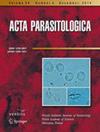Evaluating Light Trap Efficiency and Leishmania Infection Status in Sand Fly Species from Kousseri, Northern Cameroon
IF 1.5
3区 农林科学
Q4 PARASITOLOGY
引用次数: 0
喀麦隆北部库塞里地区沙蝇诱捕效果及利什曼原虫感染状况评价
背景:沙蝇在喀麦隆利什曼原虫传播中的作用仍未得到充分研究,这限制了国家控制规划的实施。为解决这一问题,从2020年9月至2021年8月,在内脏利什曼病(VL)流行疫源地库塞里开展了一项为期一年的调查,目的是评估诱光器的效率,并在沙蝇标本中检测利什曼原虫感染。并提供了喀麦隆沙蝇种类清单和分布图。材料和方法:利用美国疾病控制与预防中心(CDC)的白炽灯和紫外线(UV)微型光阱对光阱的效率进行了评估。这些诱捕器部署在库塞里选定的地点,捕获的雌性标本在形态上进行了物种水平的鉴定,并通过针对内部转录间隔区1 (ITS1)的聚合酶链反应(PCR)检测了多诺瓦利什曼原虫感染。结果:共采集雌蚊2150只,鉴定出3属11种,其中蛇形蝇属81.44%,草蝇属17.49%,白蛉属1.07%。紫外光诱捕器捕获的沙蝇标本数量较多,特别是对沙蝇、沙蝇、沙蝇和沙蝇的捕获效果较好。没有一种沙蝇对多诺瓦利什曼原虫感染呈阳性反应。目前的研究证实了duboscqi博士的存在,它是撒哈拉以南非洲(包括喀麦隆)疫源地被证实的皮肤利什曼病(CL)媒介。根据以前关于利什曼病传播的报告,这种沙蝇可能是库塞里利什曼病的病媒。这项研究强调需要进行进一步的生态和流行病学调查,以加深我们对利什曼病传播动力学的理解,并为喀麦隆北部制定有效的控制战略提供信息。
本文章由计算机程序翻译,如有差异,请以英文原文为准。
求助全文
约1分钟内获得全文
求助全文
来源期刊

Acta Parasitologica
医学-寄生虫学
CiteScore
3.10
自引率
6.70%
发文量
149
审稿时长
6-12 weeks
期刊介绍:
Acta Parasitologica is an international journal covering the latest advances in the subject.
Acta Parasitologica publishes original papers on all aspects of parasitology and host-parasite relationships, including the latest discoveries in biochemical and molecular biology of parasites, their physiology, morphology, taxonomy and ecology, as well as original research papers on immunology, pathology, and epidemiology of parasitic diseases in the context of medical, veterinary and biological sciences. The journal also publishes short research notes, invited review articles, book reviews.
The journal was founded in 1953 as "Acta Parasitologica Polonica" by the Polish Parasitological Society and since 1954 has been published by W. Stefanski Institute of Parasitology of the Polish Academy of Sciences in Warsaw. Since 1992 in has appeared as Acta Parasitologica in four issues per year.
 求助内容:
求助内容: 应助结果提醒方式:
应助结果提醒方式:


